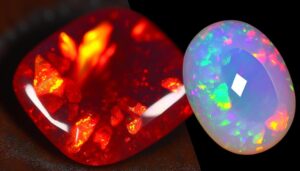Where Do You Find Fire Opals in Top Countries?
You'll find fire opals in renowned global locations. In Mexico, explore Querétaro and Jalisco for intense hues.
Australia's Lightning Ridge and Coober Pedy are top sources, noted for high silica content contributing to brilliance. Ethiopian opals, particularly from Wollo, exhibit unique hydrophane properties.
Brazilian fire opals from Piauí and Minas Gerais offer vibrant clarity. Honduras' volcanic regions, like those near Zacapa, produce distinctive black matrix opals.
In Guatemala, check Zacapa and Chiquimula for varied colors and exceptional clarity. Indonesian fire opals from Java and Sumatra showcase vibrant oranges.
Continue to uncover more about each locality's specific geological characteristics.
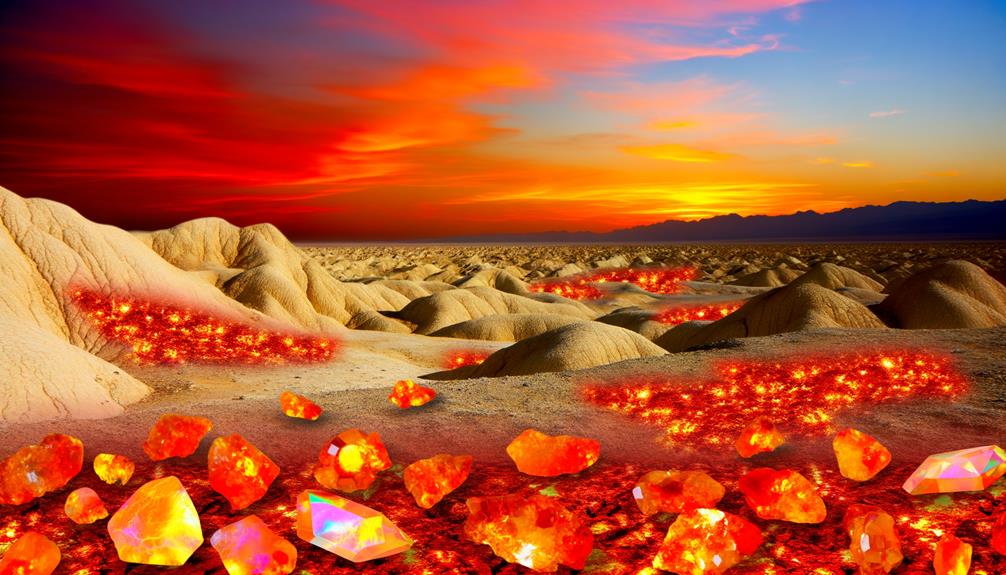
Key Takeaways
- Mexican fire opals are found in Querétaro and Jalisco, known for their intense reds, oranges, and broad color spectrum.
- Australian fire opals are sourced from Lightning Ridge, Coober Pedy, Mintabie, Andamooka, and Lambina, noted for their brilliance and rarity.
- Ethiopian fire opals come from the Wollo and Mezezo regions, characterized by high water absorption and unique hydrophane properties.
- Brazilian fire opals are mined in Piauí and Minas Gerais, prized for their vibrant hues, exceptional clarity, and chromatic intensity.
- Honduran fire opals are located in volcanic regions, especially known for their black basalt matrix and vibrant color absorption.
Mexican Mines

When searching for fire opal, Mexican mines, particularly those in Querétaro and Jalisco, are renowned for their exceptional quality and vibrant colors. You should focus on the opal mines in these regions due to their high-grade deposits.
Querétaro's opals are famous for their intense, fiery reds and oranges, which are a result of the high silica content and unique volcanic activity in the area. In Jalisco, the opals often display a broader spectrum of colors, including blues and greens, due to the presence of trace minerals.
Utilize gemological tools to assess the opal's clarity, color saturation, and play-of-color. By understanding these geological features, you can identify and select superior Mexican fire opals for your collection or projects.
Australian Sources
Australia is globally acclaimed for its high-quality fire opal deposits, particularly those found in the Lightning Ridge and Coober Pedy regions. You'll find that these areas are rich in silica, contributing to the exceptional brilliance and vibrant colors characteristic of Australian fire opals. The geological formations in these regions are ideal for opal formation, offering a unique blend of sedimentary rocks and volcanic ash.
Here's a quick comparison of Australian fire opal deposits:
| Location | Characteristics | Notable Features |
|---|---|---|
| Lightning Ridge | High silica content | Vibrant play-of-color |
| Coober Pedy | Sedimentary rock deposits | Rich color variations |
| Mintabie | Volcanic ash contributions | Unique color patterns |
| Andamooka | Mixed sedimentary layers | Distinctive hue variety |
| Lambina | Silica-rich environment | Intense color play |
Understanding these regions' unique geological conditions helps you appreciate the rarity and beauty of Australian fire opals.
Ethiopian Deposits

Shifting our focus to another dominant source, Ethiopian fire opals boast unique hydrophane properties and are mainly found in the Wollo and Mezezo regions. You'll notice these opals exhibit high water absorption, which notably affects their color and clarity. The geological formations in Ethiopia produce opals with distinct characteristics:
- Hydrophane nature: Changes in transparency and color when exposed to water.
- Play-of-color: Vivid flashes of color within the stone.
- Clarity: Generally clearer than other fire opals.
- Variety: Ranges from transparent to opaque.
- Durability: Despite being softer, they're suitable for various uses.
These attributes make Ethiopian fire opals a fascinating subject for gemologists and collectors. Understanding these traits helps in appreciating the value and uniqueness of these opals.
Brazilian Finds
You should focus on the opal mining regions in Brazil, particularly the states of Piauí and Minas Gerais.
These areas are notable for their unique geological conditions that contribute to the distinct coloration and quality of Brazilian fire opals.
Understanding these characteristics will help you appreciate why Brazilian fire opals are highly sought after in the gem market.
Opal Mining Regions
Brazil's opal mining regions, particularly in the northeastern state of Piauí, have gained recognition for their high-quality fire opals characterized by vibrant hues and exceptional clarity. The geological conditions in this region favor the formation of these exquisite gems.
When you explore these mining areas, you'll encounter:
- Alluvial deposits: Rich in opal, often found near riverbeds.
- Hydrothermal veins: Where opals form from silica-rich fluids.
- Pockets within volcanic rocks: Yielding opals with diverse color play.
- Sedimentary layers: Containing opals with unique structural features.
- Artisanal mining operations: Using traditional methods to extract opals.
These factors contribute to the remarkable quality seen in Brazilian fire opals, making the region an essential point of interest for gemologists and jewelers.
Unique Brazilian Characteristics
What sets Brazilian fire opals apart is their remarkable chromatic intensity and superior transparency, attributes that gemologists and jewelers highly prize.
You'll notice that Brazilian fire opals exhibit a vibrant red to orange hue that's more saturated compared to other sources. This coloration is due to the presence of iron oxide inclusions.
Additionally, the transparency of these opals allows for a more pronounced play-of-color, enhancing their visual appeal.
When evaluating Brazilian fire opals, you should pay close attention to their clarity and the uniformity of their color.
The mining regions in Brazil, particularly in the states of Piauí and Bahia, yield specimens that often surpass industry standards, making them highly sought after in the gemstone market.
Honduran Opals
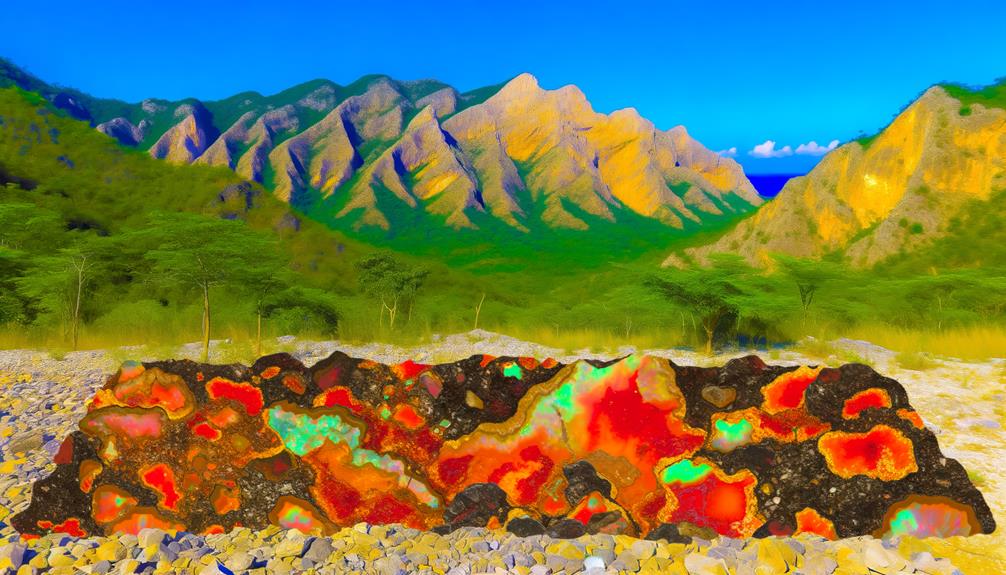
Honduran opals, primarily found in the volcanic regions of Honduras, are renowned for their unique black matrix and striking play of colors. When you examine these opals, you'll notice their exceptional characteristics:
- Black Basalt Matrix: This dark background enhances the opal's vibrant colors.
- Play-of-Color: Look for flashes of red, green, blue, and orange.
- Porous Structure: This allows for better absorption of light, intensifying the colors.
- Silica-Rich Composition: Essential for the opal's formation and brilliance.
- Volcanic Origin: Indicates a high mineral content and unique formation process.
Analyzing these features, you'll see why Honduran opals stand out. They're prized for their distinct appearance and geological significance, offering a unique addition to any gem collection.
Nevada Fire Opals
Shifting from the volcanic regions of Honduras to the rich mining areas of Nevada, you'll discover that Nevada fire opals are equally enchanting with their fiery hues and transparent to translucent bodies. Located primarily in the Virgin Valley, these opals exhibit play-of-color phenomena, showcasing a spectrum of reds, oranges, and yellows.
The mining process involves both open-pit and underground methods, requiring precise extraction techniques to prevent damage to the delicate stones. When you analyze these opals, you'll note their high water content, which can occasionally lead to instability.
Nevertheless, their unique color patterns and geological formation make them highly sought after by both collectors and jewelers. Understanding their provenance and characteristics enhances your appreciation of these remarkable gemstones.
Oregon Discoveries
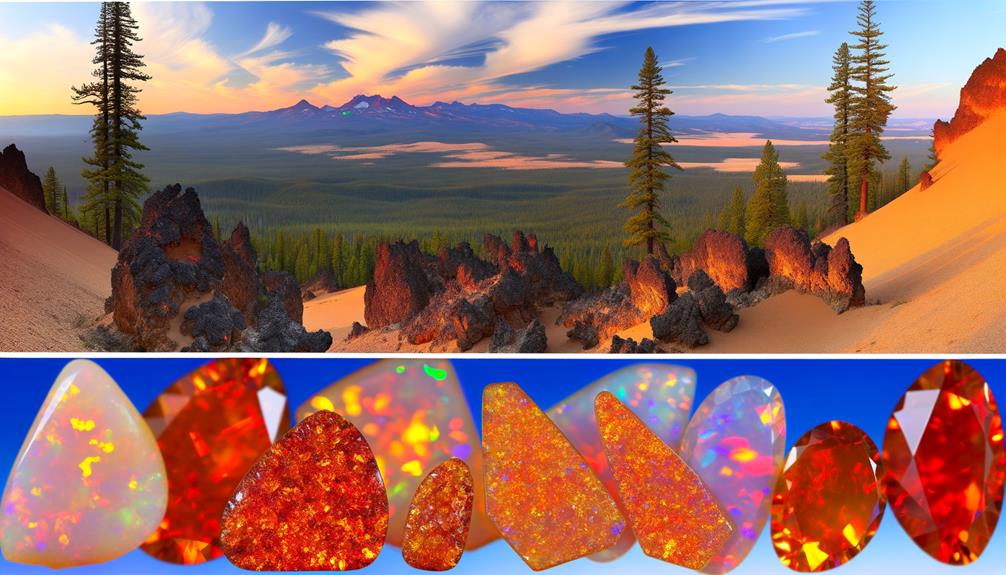
In Oregon, you'll find significant fire opal deposits at Opal Butte, a site known for its high-quality specimens.
Additionally, Sunstone Knoll offers unique opportunities to locate sunstone opals, a variety distinct to this region.
Opal Butte Riches
Nestled in the Blue Mountains of Oregon, Opal Butte is renowned for its high-quality fire opals, making it a prime destination for gem enthusiasts and professional miners alike. The geological formations here offer a unique opportunity to find opals with vivid play-of-color and exceptional clarity.
When you explore Opal Butte, you'll encounter:
- Silica-rich volcanic rock formations
- Hydrothermal veins rich in mineral deposits
- Natural erosion revealing opal seams
- Pockets of opalized wood and fossilized material
- Distinct coloration from trace elements like iron and manganese
Utilizing methods such as careful excavation and sieving, you'll maximize your chances of uncovering these precious gems. Each find not only adds to your collection but enriches your understanding of geological processes.
Sunstone Knoll Locations
You'll discover that Sunstone Knoll, located in Oregon's high desert, offers a unique geological setting ideal for finding sunstones with remarkable clarity and color. The area is characterized by its volcanic basalt flows and tuff beds, which provide a fertile matrix for sunstone formation.
You'll find these gem-quality feldspar crystals embedded within the basalt, often requiring careful extraction techniques to preserve their integrity. Look for areas where erosion has exposed these layers, as they increase the likelihood of surface finds. Employing tools like rock hammers and chisels will aid in accessing deeper deposits.
This region's geological conditions—high silica content and rapid cooling—contribute to the sunstones' unique hues, ranging from pale yellow to deep red.
Virgin Valley Finds
For those seeking another geological treasure in Oregon, head to Virgin Valley, renowned for its exceptional fire opal deposits. This region is a prime location for finding high-quality fire opals, characterized by their vibrant play-of-color and transparency.
When prospecting in Virgin Valley, keep an eye out for:
- Hydrophane Opals that absorb water and change appearance
- Seam Opals found in thin veins within host rock
- Nodule Opals occurring as isolated masses
- Matrix Opals embedded in the surrounding rock matrix
- Contrasting Color Patterns indicating high-value specimens
To maximize your success, use proper tools like rock hammers and sieves. Analyze the geological formations and sediment layers for best excavation sites. Understanding these characteristics ensures a rewarding and scientifically-informed opal hunting experience.
Guatemalan Locations
Guatemalan fire opal deposits are primarily found in the volcanic regions of the country, particularly in the departments of Zacapa and Chiquimula. These regions are rich in silica-rich volcanic rock, providing ideal conditions for the formation of fire opals. The volcanic activity in these areas has created a unique environment where you can find high-quality opals with vibrant colors and exceptional clarity.
| Department | Key Characteristics |
|---|---|
| Zacapa | High silica content, vibrant colors |
| Chiquimula | Exceptional clarity, diverse sizes |
| Quetzaltenango | Varied color spectrum, good transparency |
| Jalapa | Rich deposits, unique hues |
When exploring these regions, focus on areas with historical volcanic activity and assess the geological formations to identify potential opal deposits.
Indonesian Opals
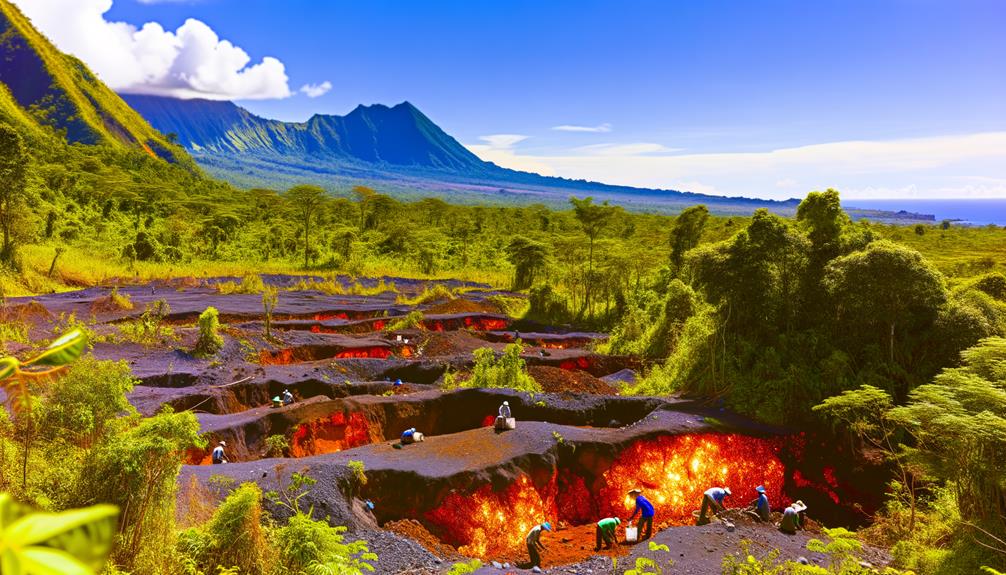
You'll find Indonesian opals distinct for their unique color variations, ranging from vibrant oranges to deep reds.
To locate these gemstones, focus on the mining regions in Java and Sumatra, where geological conditions favor opal formation.
Evaluate the mineral composition and extraction techniques to understand their quality and availability.
Unique Color Variations
Exploring the unique color variations of Indonesian fire opals reveals a mesmerizing spectrum that ranges from vivid oranges to deep reds, each hue reflecting the volcanic origins of these gemstones. You'll notice that the chromatic diversity in these opals is unparalleled, showcasing:
- Fiery orange: Evokes the molten lava from which the stones originate.
- Deep crimson: Resembling the cooling magma.
- Golden yellow: Hints at the sulfuric elements present in volcanic environments.
- Reddish-brown: Suggests oxidation processes affecting iron content.
- Translucent hues: Allow light to play through the gem, enhancing its brilliance.
These color variations stem from the trace elements and mineral inclusions within the opal, influenced by volcanic activity. Understanding these intricate details helps you appreciate the geological artistry behind each Indonesian fire opal.
Mining Locations Overview
Indonesian fire opals are frequently mined from the volcanic regions of Java and Sumatra, where geothermal activity creates the perfect conditions for their formation. When you're exploring these areas, you'll find that the opals form in rhyolite, basalt, or other igneous rocks due to high silica content and rapid cooling.
The geothermal waters percolate through the volcanic rock, depositing silica in the cavities and seams, leading to opal formation. Java's Mount Merapi and Sumatra's Lake Toba are particularly notable for their rich deposits.
You should know that mining these opals requires precise techniques to avoid damaging the delicate stones. Understanding the geological processes and careful extraction methods is essential for anyone interested in sourcing high-quality Indonesian fire opals.
Turkish Mines
Turkish mines, particularly those in the Anatolian region, are renowned for producing high-quality fire opals with vibrant color play. You'll find opals here that exhibit a spectrum of hues and intricate patterns. The geological conditions unique to this region contribute to the creation of opals with exceptional clarity and stability.
Key characteristics of Turkish fire opals include:
- Intense orange-red hues: These colors are particularly sought after for their rarity and brilliance.
- High transparency: This allows for a more vivid display of the internal color play.
- Stable matrix: Guarantees durability and resistance to cracking.
- Hydrophane properties: Some opals absorb water, changing in appearance.
- Fine microstructure: Results in a smoother polish and better light refraction.
Understanding these qualities will deepen your appreciation of Turkish fire opals.
Buying Tips

When purchasing fire opals, prioritize evaluating the intensity of their color play and the stone's overall transparency to make sure you acquire a high-quality gem. Examine the opal under various lighting conditions to assess its color spectrum and brightness.
High-grade fire opals exhibit vibrant hues, mainly reds, oranges, and yellows, with minimal cloudiness. Inspect the stone for inclusions or fractures, which can affect its durability and value.
Verify the opal's carat weight, as size greatly impacts pricing. Always request certification from a reputable gemological laboratory to confirm authenticity and quality.
Consider the opal's cut and polish, ensuring it maximizes the stone's natural beauty and brilliance. By following these guidelines, you'll make an informed purchase.
Conclusion
In your quest for fire opals, you'll traverse a world rich with geological wonders. From Mexico's vibrant mines to Ethiopia's burgeoning deposits, each location offers unique allure.
Remember, thorough research and judicious buying tips will guide you. The fire opal's radiant blaze, a demonstration of Earth's artistry, awaits your discovery.
Dive deep into these global sources, and you'll not just find opals but also unearth stories etched in every fiery facet. The journey is as precious as the gem itself.




